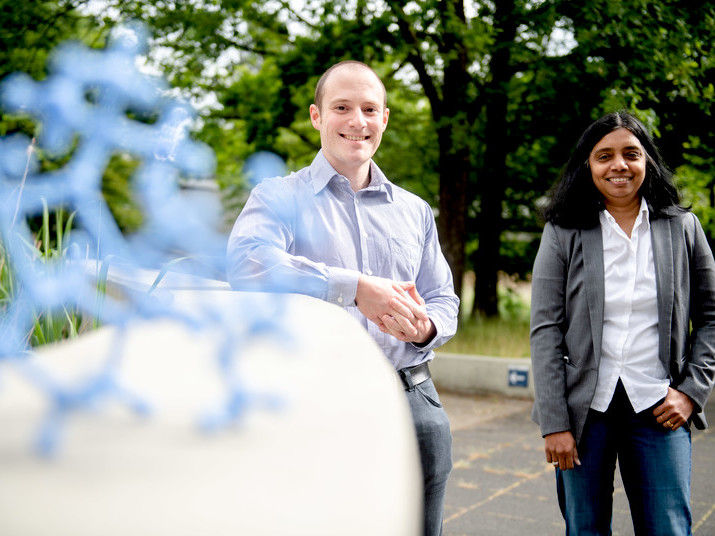New access to the interior of electronic components
Potential application: sensors for chemical substances
An interdisciplinary team at the Ruhr-Universität Bochum has found a way of accessing the interior of transistors. The researchers have manipulated the electron gas contained within by applying resonators to generate rhythmic oscillation in the terahertz range inside.
Transistors can be manipulated not only with voltages
Used for switching and amplifying, transistors are fundamental elements of modern electronics. By applying a specific voltage externally to a transistor, an electric current is controlled inside, which, in turn, generates a new voltage. Compared with the externally applied voltage, the new voltage may be amplified, may oscillate or be logically connected to it. In order to interact with their surroundings via electric current and voltage, transistors contain ultra-thin electron layers, so-called 2D electron gases. The RUB team demonstrated that these gases can be controlled not only via DC and radio-frequency voltages.
Electron gas can be oscillated like jelly
"A 2D electron gas is like jelly," explains Prof Dr Andreas Wieck from the Chair for Applied Solid State Physics. "If pressure is electrically applied to the gas from above with a characteristic frequency, thickness and density oscillations are generated." Accordingly, the gas can be manipulated via electric forces, which oscillates much more rapidly than any radio or microwave frequency. As it has a thickness of just about ten nanometres, the oscillations follow the laws of quantum mechanics. This means: all occurring oscillations have a specific frequency, namely in the terahertz range, i.e. in the range of 1012 Hertz. "Pressure to the electron gas must be applied in that rapid change," elaborates Wieck. Andreas Wieck, Dr Shovon Pal, Dr Nathan Jukam and other colleagues from the workgroup Terahertz Spectroscopy and Technology as well as from the Chair of Electronic Materials and Nanoelectronics have found a way to trigger the required oscillations. Thus, a new method of accessing the interior of a transistor has been created.
Resonators generate thickness oscillations
One hundred nanometres above the electron gas, the RUB researchers evaporated an array of identical metallic resonators which can oscillate with the required fixed frequency. The electron gas was embedded in a semiconductor and could be modified via external DC voltage, namely it could be made a bit thicker or thinner. The thickness determines the frequency which makes the gas oscillate optimally. Deploying external voltage, the researchers were able to fine-tune the electron gas to the resonators, i.e. adjust the gas so that the alternating electric pressure of the resonators excites it optimally to oscillate in the terahertz range.
Sensors for chemical and environmental technology
This method could be of interest for sensors in chemical and environmental applications, as the researchers suggest. This is because molecule oscillations typically happen in the terahertz range. With modified transistors, such oscillations can be recorded and sensors can be developed that react to the frequencies of certain gases or liquids.
Original publication
Other news from the department science
These products might interest you

SprayMaster inspex by LaVision
Quality Control for Your Spraying Process Through Digital Spray and Particle Analysis
Reliable, Automated, Digital - The Geometry Measurement of Your Spraying Process in Real Time

FireSting-PRO by PyroScience
New fiber optic measuring device: Precise measurements even in the smallest volumes
Measure pH, oxygen and temperature even under sterile conditions

VEGAPULS | VEGABAR | VEGASWING by VEGA Grieshaber
Cyber-safe level measurement - here's how it works
Find out more about the unique sensor for liquid and solid media

Get the chemical industry in your inbox
By submitting this form you agree that LUMITOS AG will send you the newsletter(s) selected above by email. Your data will not be passed on to third parties. Your data will be stored and processed in accordance with our data protection regulations. LUMITOS may contact you by email for the purpose of advertising or market and opinion surveys. You can revoke your consent at any time without giving reasons to LUMITOS AG, Ernst-Augustin-Str. 2, 12489 Berlin, Germany or by e-mail at revoke@lumitos.com with effect for the future. In addition, each email contains a link to unsubscribe from the corresponding newsletter.
Most read news
More news from our other portals
See the theme worlds for related content
Topic World Spectroscopy
Investigation with spectroscopy gives us unique insights into the composition and structure of materials. From UV-Vis spectroscopy to infrared and Raman spectroscopy to fluorescence and atomic absorption spectroscopy, spectroscopy offers us a wide range of analytical techniques to precisely characterize substances. Immerse yourself in the fascinating world of spectroscopy!

Topic World Spectroscopy
Investigation with spectroscopy gives us unique insights into the composition and structure of materials. From UV-Vis spectroscopy to infrared and Raman spectroscopy to fluorescence and atomic absorption spectroscopy, spectroscopy offers us a wide range of analytical techniques to precisely characterize substances. Immerse yourself in the fascinating world of spectroscopy!
Topic world Sensor technology
Sensor technology has revolutionized the chemical industry by providing accurate, timely and reliable data across a wide range of processes. From monitoring critical parameters in production lines to early detection of potential malfunctions or hazards, sensors are the silent sentinels that ensure quality, efficiency and safety.

Topic world Sensor technology
Sensor technology has revolutionized the chemical industry by providing accurate, timely and reliable data across a wide range of processes. From monitoring critical parameters in production lines to early detection of potential malfunctions or hazards, sensors are the silent sentinels that ensure quality, efficiency and safety.
Last viewed contents

An unusual cobalt compound - Interesting for applications in the field of battery or accumulator production
Harvey_Bialy
Category:Biofuel_power_stations_in_England
Category:Romanian_chemists




























































